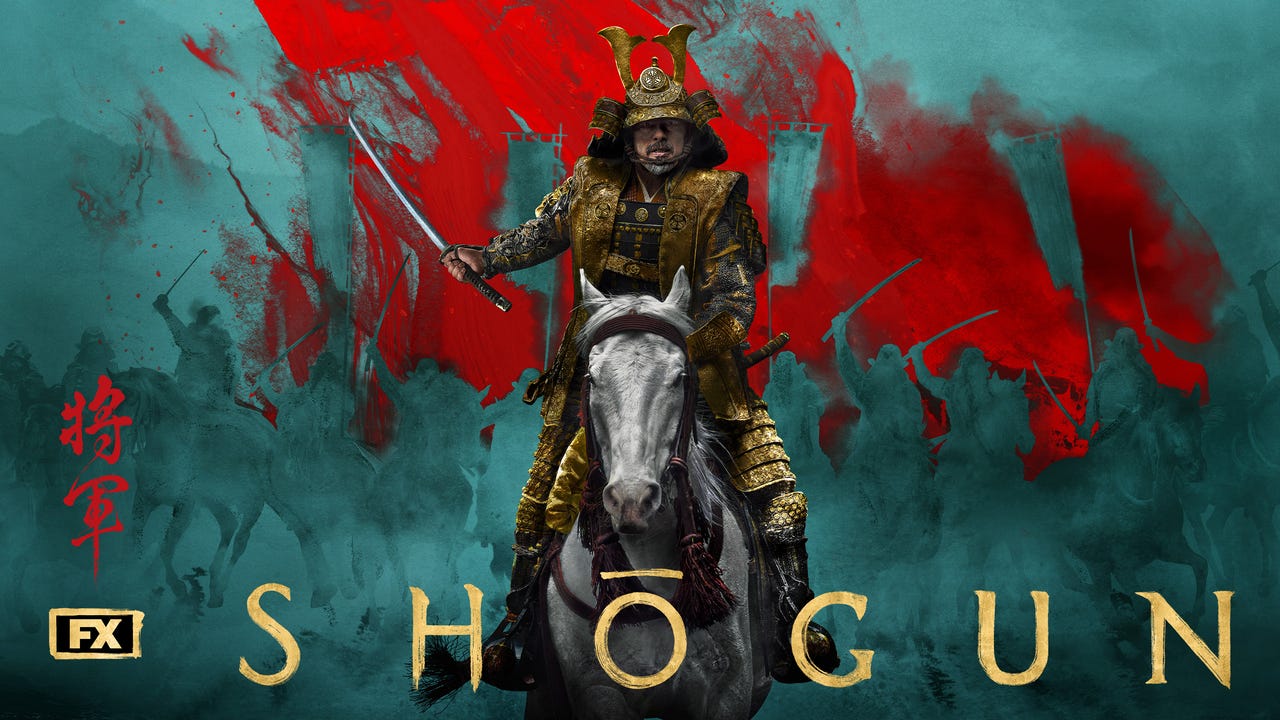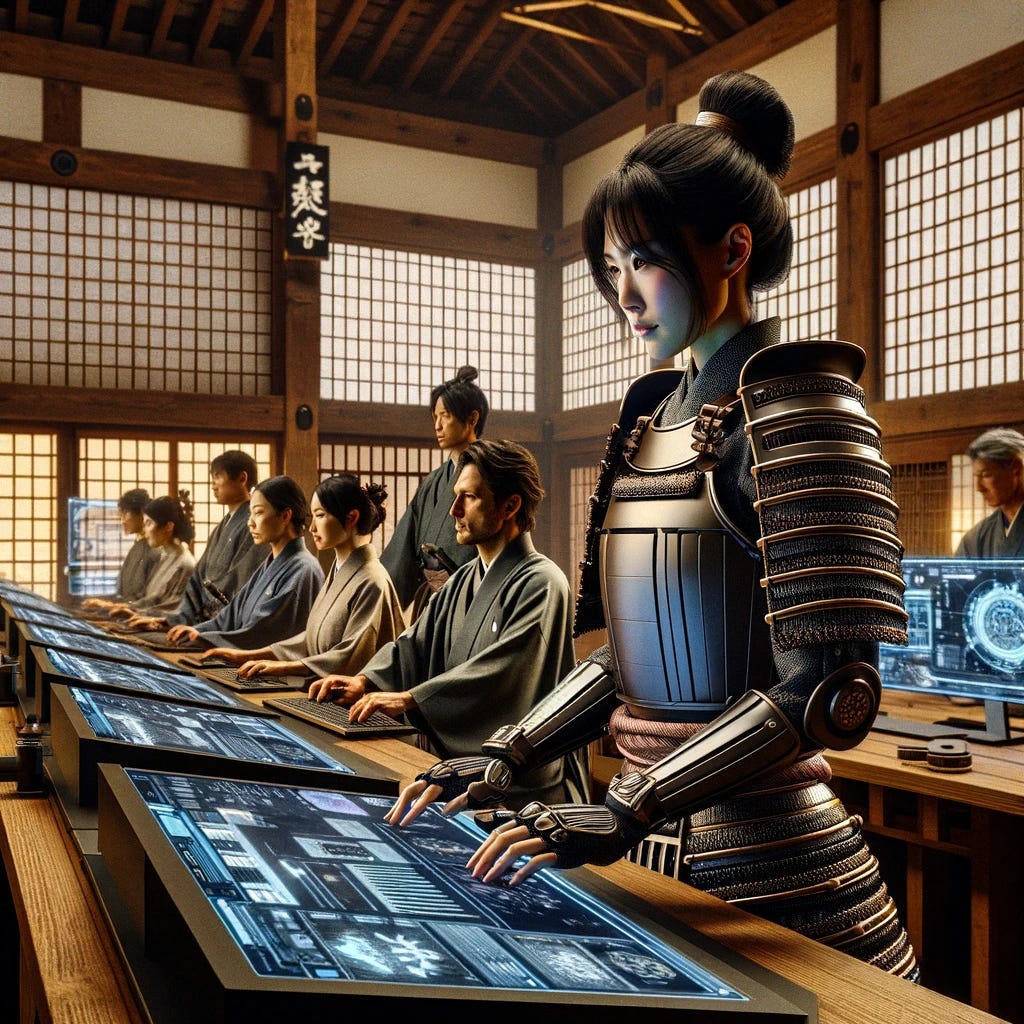3 takeaways from the TV series Shogun
for product managers. Read real-world examples on how to apply the takeaways, and seek inspiration from unconventional experiences.
When I watch shows or read books, I closely observe the characters and try to understand why they are the way they are. My mind buzzes with ideas about how to apply traits of these characters to my own life - personal or professional. I believe that many problems we face have already been solved by someone before us, and our process of finding solutions is simply mixing and adapting of past lessons within the context of the current world.
Image generated with DALL-E (Prompt: a female japanese samurai surrounded by a japanese garden while working on a computer)
This article is based on the TV series, Shogun. Shogun is a 10-episode TV series that is based on a historical fiction novel by James Clavell. It is based on in 17th century feudal Japan and follows 3 main characters - an English sailor who ends up shipwrecked in Japan, Lord Toranaga, a Japanese leader at odds with his political rivals, and Lady Mariko who is from a dishonorable family and has a key role to prove her loyalties.
Image credits: TV Insider
I map observations from Shogun to my experiences working as a Product Manager. Hopefully this serves as a useful read to build your own product skillset.
⚠️⚠️ STOP HERE if you haven’t watched the show. I don’t want to spoil the show for you. Also the rest of this article will make a lot more sense only if you’ve watched the show. So please go watch it first :) Here are three takeaways that Product Managers can derive from the TV series Shogun:
Embrace the Beginner's Mindset: One of the central characters in Shogun, an English sailor, finds himself shipwrecked in an entirely foreign land – Japan. Despite his initial confusion and culture shock, he mostly approaches the situation with curiosity, humility, and a willingness to learn. This "beginner's mindset" allows him to gain valuable insights, adapt to his new surroundings, and build trust with people around him.
As Product Managers, it's essential to cultivate this mindset, no matter how many years of experience you have. Approaching new, unfamiliar territories with an open mind, shedding preconceptions, and be willing to learn from those with deeper contextual understanding will go a long way to build your own product intuition.
I enjoy dogfooding products I’m building and competitors products to gain insights on my product domain. At Yelp, within the Restaurants group, all employees were encouraged to sign up to be a restaurant host for an evening to build deep levels of empathy. I learnt a ton about how the products we build are used in the real world. At eBay, we did a 2-day workshop at a customer support center, helping people navigate and find information on eBay. At Instagram, as Reels was gaining popularity as a format, I created a content creator profile and now deeply understand why creating content and growing followers is challenging.
Appreciate the Art of Patience and Persistence: Japanese culture, as depicted in Shogun, emphasizes patience, persistence, and a long-term perspective. From the long-view of strategy Lord Toranaga takes to besting his political rivals, to the reconstruction of homes post an earthquake - both story arcs are meaningful to learn from. All great things take time to build, and staying adaptable at every step of the way and doing what’s right often leads to a solution to make progress.
Product Managers can learn from these arcs - recognizing that building successful products often requires a similar level of patience and perseverance. The right thing isn’t devising the perfect long-term strategy, those bets are typically for the CEO to make. But in majority of the cases, exhibiting patience and not giving up when things look bleak, is helpful. Everything in tech is dynamic and changes quickly.
I build roadmaps with a portfolio lens allocating a % of projects under the themes of tablestakes, differentiators, big bets. However, the temptation for quick wins or shortcuts is always present, especially when there’s pressure to hit goals. now I try to ensure we have product principles while building solutions. These principles may include doing what’s right for the customers, avoiding 1-way doors, and ensure a high bar for design craft. Principles help remind us of the bigger picture and prevent shortcuts or hacky ideas from shipping
Don't Underestimate the Power of Simplicity and Focus: Throughout Shogun, we witness the Japanese appreciation for simplicity, minimalism, and focus. Simplicity of the homes and gardens, focussed tea/sake ceremonies, contemplation in the woods, there is a deliberate emphasis on distilling experiences to their essence without too many distractions.
As Product Managers, we can sometimes fall into the trap of feature bloat, adding unnecessary complexity in an attempt to appeal to all potential users. Doing a few things well is better than doing many things sub-par.
My #1 lesson in writing a product strategy has been to get the target segment right. Having a strong POV on what % of the total addressable market (TAM) is winnable with the product plans is far better than touting the overall TAM, who may or may not find value. With a clear segment, it feels easier to prioritize core functionalities and validate / deliver a focused and streamlined outcome. It also helps to articulate a differentiating experience relative to other offerings.
Being a product manager is hard. It involves managing a lot of priorities, nurturing relationships, all while keeping your cool and peace of mind. Good news is because the role can be fluid, there’s a lot to learn and feel inspired from atypical sources too. In this case, I found a lot of inspiration from the TV series Shogun. Please comment and let me know where you find your untraditional inspiration from.
Image generated with DALL-E (Prompt: a modern day female japanese samurai working in a japanese castle along with teammates)
Note: I’m stoked I used AI tools to get this post out. My workflow:
[1] Watched Shogun
[2] Recorded my thoughts on my phone using superwhisper
[3] Sent the AI-output via Whatsapp to my desktop
[4] Copy/pasted into Claude; Used a prompt from the Anthropic library to format into a short form essay
[5] Edited the article for original thought, personal examples; Double-checked grammar with Claude.
[6] Generated images using DALL-E and MetaAI, but picked DALL-E cause they were better.
#2 would’ve taken me a few hours to write on a blank paper, took me <5 minutes to capture.
#4 was nice, quick way to transform my raw notes into a summarized short form essay. Something that would’ve previously taken a few hours, now <1 minute. lol
#5 is the differentiator imo, which AI cannot replace, and what I enjoyed doing the most. The time spent on this part felt worth it.






